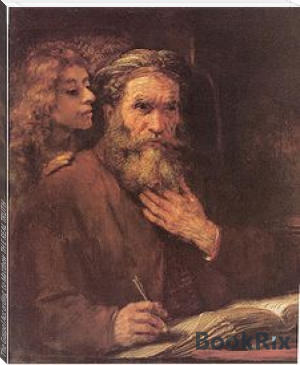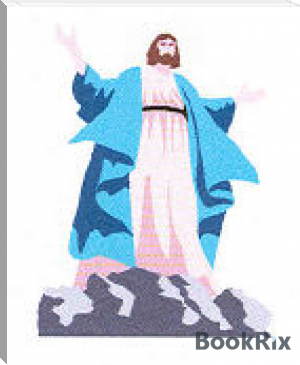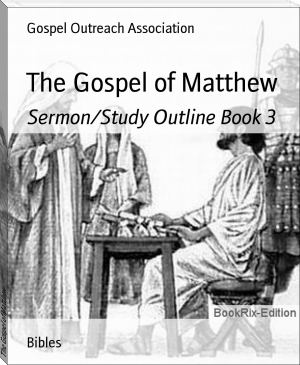The Gospel According to Matthew THE REAL TRUTH by JACOB GEORGE (robert munsch read aloud TXT) 📕

- Author: JACOB GEORGE
Book online «The Gospel According to Matthew THE REAL TRUTH by JACOB GEORGE (robert munsch read aloud TXT) 📕». Author JACOB GEORGE
Historical background
gospel his vision "of an assembly or church in which both Jew and Gentile would flourish together."
Structure and content
Beginning of the Gospel of Matthew in Minuscule 447
Structure
Matthew, alone among the gospels, alternates five blocks of narrative with five of discourse, marking each off with the phrase "When Jesus had finished..." (see Five Discourses of Matthew). Some scholars see in this a deliberate plan to create a parallel to the first five books of the Old Testament; others see a three-part structure based around the idea of Jesus as Messiah; or a set of weekly readings spread out over the year; or no plan at all. Davies and Allison, in their widely used commentary, draw attention to the use of "triads" (the gospel groups things in threes), and R. T. France, in another influential commentary, notes the geographic movement from Galilee to Jerusalem and back, with the post-resurrection appearances in Galilee as the culmination of the whole story.
Historical background
Prologue: genealogy, nativity and infancy
Main articles: Genealogy of Jesus and Nativity of Jesus
The Gospel of Matthew begins with the words "The Book of Genealogy [in Greek, "Genesis"] of Jesus Christ", deliberately echoing the words of Genesis 2:4 in the Old Testament in Greek. The genealogy tells of Jesus' descent from Abraham and King David and the miraculous events surrounding his virgin birth, and the infancy narrative tells of the massacre of the innocents, the flight into Egypt, and eventual journey to Nazareth.
First narrative and discourse
Main articles: Baptism of Jesus and Sermon on the Mount
The first narrative section begins. John baptizes Jesus, and the Holy Spirit descends upon him. Jesus prays and meditates in the wilderness for forty days, and is tempted by Satan. His early ministry by word and deed in Galilee meets with much success, and leads to the Sermon on the Mount, the first of the discourses. The sermon presents the ethics of the kingdom of God, introduced by the Beatitudes ("Blessed are..."). It concludes with a reminder that the response to the kingdom will have eternal consequences, and the crowd's amazed response leads into the next narrative block.
Second narrative and discourse
From the authoritative words of Jesus the gospel turns to three sets of three miracles interwoven with two sets of two discipleship stories (the second narrative), followed by a discourse on mission and suffering. Jesus commissions the Twelve Disciples and sends them to preach to the Jews, perform miracles, and prophesy the imminent coming of the Kingdom, commanding them to travel lightly, without staff or sandals.
Historical background
Third narrative and discourse
Opposition to Jesus comes to a head with accusations that his deeds are done through the power of Satan; Jesus in turn accuses his opponents of blaspheming the Holy Spirit. The discourse is a set of parables emphasizing the sovereignty of God, and concluding with a challenge to the disciples to understand the teachings as scribes of the kingdom of heaven. (Matthew avoids using the holy word God in the expression "Kingdom of God"; instead he prefers the term "Kingdom of Heaven", reflecting the Jewish tradition of not speaking the name of God).
Fourth narrative and discourse
Main article: Confession of Peter
The fourth narrative section reveals that the increasing opposition to Jesus will result in his crucifixion in Jerusalem, and that his disciples must therefore prepare for his absence. The instructions for the post-crucifixion church emphasize responsibility and humility. (This section contains Matthew 16:13–19, in which Simon, newly renamed Peter, (πέτρος, petros, meaning "stone"), calls Jesus "the Christ, the son of the living God", and Jesus states that on this "bedrock" (πέτρα, petra) he will build his church—the passage forms the foundation for the papacy's claim of authority).
Fifth narrative and discourse
Main article: Second Coming
Jesus travels toward Jerusalem, and the opposition intensifies: he is tested by Pharisees as soon as he begins to move towards the city, and when he arrives he is soon in conflict with the Temple and other religious leaders. The disciples ask about the future, and in his final discourse (the Olivet Discourse) Jesus speaks of the coming end. There will be false Messiahs, earthquakes, and persecutions, the sun, moon, and stars will fail, but "this generation" will not pass away before all the prophecies are fulfilled. The disciples must steel themselves for ministry
to all the nations. At the end of the discourse Matthew notes that Jesus has finished all his words, and attention turns to the crucifixion.
Historical background
Conclusion: Passion, Resurrection and Great Commission
The events of Jesus' last week occupy a third of the content of all four gospels. Jesus enters Jerusalem in triumph and drives the money changers from the temple, holds a last supper, prays to be spared the coming agony (but concludes "if this cup may not pass away from me, except I drink it, thy will be done"), and is betrayed. He is tried by the Jewish leaders (the Sanhedrin) and before Pontius Pilate, and Pilate washes his hands to indicate that he does not assume responsibility. Jesus is crucified as king of the Jews, mocked by all. On his death there is an earthquake, the veil of the Temple is rent, and saints rise from their tombs. Mary Magdalene and another Mary discover the empty tomb, guarded by an angel, and Jesus himself tells them to tell the disciples to meet him in Galilee.
After the resurrection the remaining disciples return to Galilee, "to the mountain that Jesus had appointed," where he comes to them and tells them that he has been given "all authority in heaven and on Earth." He gives the Great Commission: "Therefore go and make disciples of all the nations, baptizing them in the name of the Father and of the Son and of the Holy Spirit, teaching them to obey everything that I have commanded you;" Jesus will be with them "to the very end of the age."
Theology
Woodcut from Anton Koberger's Bible (Nuremberg, 1483): The angelically inspired Saint Matthew musters the Old Testament figures, led by Abraham and David
Historical background
Christology
Christology is the theological doctrine of Christ, "the affirmations and definitions of Christ's humanity and deity". There is a variety of Christologies in the New Testament, albeit with a single centre - Jesus is the figure in whom God has acted for mankind's salvation.
Matthew has taken over his key Christological texts from Mark, but sometimes he has changed the stories he found in Mark, giving evidence of his own concerns. The title Son of David identifies Jesus as the healing and miracle-working Messiah of Israel (it is used exclusively in relation to miracles), and the Jewish messiah is sent to Israel alone. As Son of Man he will return to judge the world, a fact his disciples recognise but of which his enemies are unaware. As Son of God he is named Immanuel (God with us) (Matthew 1:23), God revealing himself through his son, and Jesus proving his sonship through his obedience and example.
Relationship with the Jews
Matthew's prime concern was that the Jewish tradition should not be lost in a church increasingly becoming gentile. This concern lies behind the frequent citations of Jewish scripture, the evocation of Jesus as the new Moses along with other events from Jewish history, and the concern to present Jesus as fulfilling, not destroying, the Law. According to Dale Allison, Matthew, unlike Paul and like Luke, believed that the Law was still in force, which meant that Jews within the church had to keep it.
The gospel has been interpreted as reflecting the struggles and conflicts between the evangelist's community and the other Jews, particularly with its sharp criticism of the scribes and Pharisees. Prior to the Crucifixion the Jews are called Israelites, the honorific title of God's chosen people; after it, they are called "Ioudaioi", Jews, a sign that through their rejection of the Christ the "Kingdom of Heaven" has been taken away from them and given instead to the church.
Historical background
Comparison with other writings
Christological Development
The divine nature of Jesus was a major issue for the community of Matthew, the crucial element marking them off from their Jewish neighbors.[citation needed] Early understandings[who?] of this nature grew as the gospels were being written. Before the gospels, that understanding was focused on the revelation of Jesus as God in his resurrection, but the gospels reflect a broadened focus extended backwards in time. The gospel of Mark recounts prior revelations in Jesus' lifetime on earth, at his baptism and transfiguration. Matthew and Luke go back further still, showing Jesus as the Son of God from his birth. Matthew most of all the gospels identifies how his coming to earth was the fulfillment of many Old Testament prophecies. Finally John calls God the Word (Jesus) pre-existent before creation, and thus before all time.
Matthew is a creative reinterpretation of Mark, stressing Jesus' teachings as much as his acts, and making subtle changes in order to stress his divine nature – Mark's "young man" who appears at Jesus' tomb, for example, becomes a radiant angel in Matthew. The miracle stories in Mark do not demonstrate the divinity of Jesus, but rather confirm his status as an emissary of God (which was Mark's understanding of the Messiah).
Chronology
There is a broad disagreement over chronology between Matthew, Mark and Luke on one hand and John on the other: all four agree that Jesus' public ministry began with an encounter with John the Baptist, but Matthew, Mark and Luke follow this with an account of teaching and healing in Galilee, then a trip to Jerusalem where there is an incident in the Temple, climaxing with the crucifixion on the day of the Passover holiday. John, by contrast, puts the Temple incident very early in Jesus' ministry, has several trips to Jerusalem, and puts the crucifixion immediately before the Passover holiday, on the day when the lambs for the Passover meal were being sacrificed in Temple.
Historical background
In art
The Chi Rho monogram from the Book of Kells is the most lavish such monogram
In Insular Gospel Books (copies of the Gospels produced in Ireland and Britain under Celtic Christianity), the first verse of Matthew's genealogy of Christ was often treated in a decorative manner, as it began not only a new book of the Bible, but was the first verse in the Gospels.
Theme
Matthew’s main purpose is to prove to his Jewish readers that Jesus is their Messiah. He does this primarily by showing how Jesus in his life and ministry fulfilled the OT Scriptures. Although all the Gospel writers quote the OT, Matthew includes nine proof texts unique to his Gospel (1:22–23; 2:15; 2:17–18; 2:23; 4:14–16; 8:17; 12:17–21; 13:35; 27:9–10) to drive home his basic theme: Jesus is the fulfillment of the OT predictions of the Messiah. Matthew even finds the history of God’s people in the OT recapitulated in some aspects of Jesus’ life (see, e.g., his quotation of Hos 11:1 in 2:15). To accomplish his purpose Matthew also emphasizes Jesus’ Davidic lineage.
Author
Although the first Gospel is anonymous, the early church fathers were unanimous in holding that Matthew, one of the 12 apostles, was its author. However, the results of modern critical studies—in particular those that stress Matthew’s alleged dependence on Mark for a substantial part of his Gospel—have caused some Biblical scholars to abandon Matthean authorship. Why, they ask, would Matthew, an eyewitness to the events of our Lord’s life, depend so heavily on Mark’s account? The best answer seems to be that he agreed with it and wanted to show that the apostolic testimony to Christ was not





Comments (0)